- Home/
- Maharashtra State Exams (MPSC)/
- Article
Ancient History of Maharashtra, Download PDF, MPSC History Notes
By BYJU'S Exam Prep
Updated on: September 25th, 2023

The present-day Maharashtra region has seen many kingdoms of ancient India. In the region where the territories of Maharashtra lied, these kingdoms were extended over a large part of the Indian subcontinent. The prominent empire includes the Maurya empire, Satvahana dynasty, Kadamba dynasty, Vakataka dynasty, Chalukya dynasty and Rashtrakuta dynasty.
Download BYJU’S Exam Prep App and prepare General Knowledge for Maharashtra State exams.
Table of content
Ancient History of Maharashtra
- Prominently, the Maharashtra region in ancient times was demarcated into north Konkan (Aparanta) with Puri as its capital and South Konkan (Sapta-Konkan, the region with seven Konkani). Numerous ports and creeks in the region have been playing a significant role in shaping the Maharashtra culture. There have been foreign influences during trade and commerce. Likewise, the chalcolithic culture of Maharashtra was significantly transformed by the foreign immigrants who entered South India through the ports and creeks of Konkan.
- This topic is important for MPSC Rajyaseva, MPSC Combined, MPSC Group C, MPSC CDPO and other Maharashtra State exams.
- Eventually, the megalithic culture of Maharashtra evolved. The megalithic builders or architects were the people of Mediterranean origin who came to the western coast by sea. Gradually, they entered South India in about 500 B.C. and spread northward, subduing the earlier neolithic and microlithic people who were in a semi-nomadic, food-gathering stage of culture.
- The Konkan region witnessed commercial dealings with several western countries such as Iran, Iraq, Africa and Egypt. Like that of Maharashtra, the Chalcolithic culture of Konkan may have been affected by the advent of the Aryans of North India rather than by the immigrants from the west.
Important Links for MPSC Rajyaseva (State Services) Prelims Exam 21 August 2022 –
- MPSC Analysis 2022
- MPSC Cut Off 2022 Expected
- MPSC Question Paper 2022 PDF
- MPSC Answer Key 2022
- MPSC Rajyaseva Prelims Exam Analysis 2022
- MPSC Rajyaseva Prelims Exam Analysis in Marathi
- MPSC Answer Key 2022 PDF Paper 1, 2 – SET A/B/C/D
- MPSC Answer Key 2022 PDF in Marathi
- MPSC Expected Cut Off Marks in Marathi
- MPSC GS, CAST Question Paper 2022 in Marathi
Prominent Dynasties of the Region
a. Ashmakas & Vidarbhas – Ashmaka and Vidarbha were the name of a Mahajanapada in present Maharashtra.
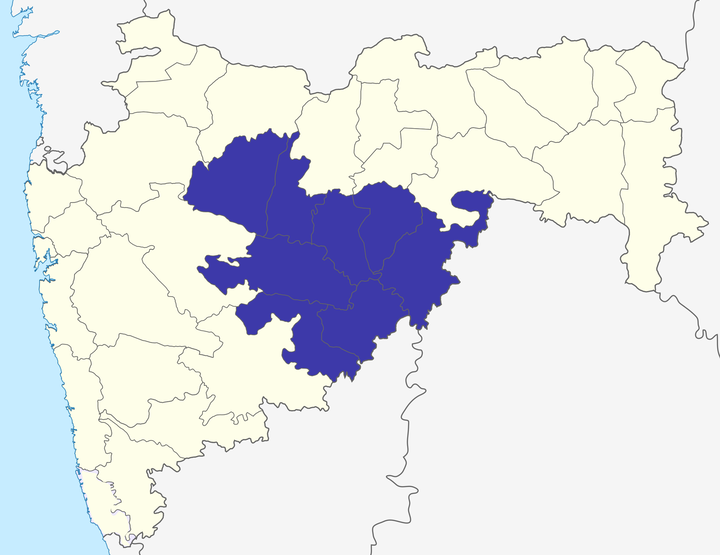
b. Mauryas – They ruled almost the whole of India. A rock inscription of Ashoka has been found at Nala Sopara (Near Mumbai) in Maharashtra confirms the Mauryan regime. The Maurya Empire ruled Maharashtra in the 4th and 3rd century BCE.
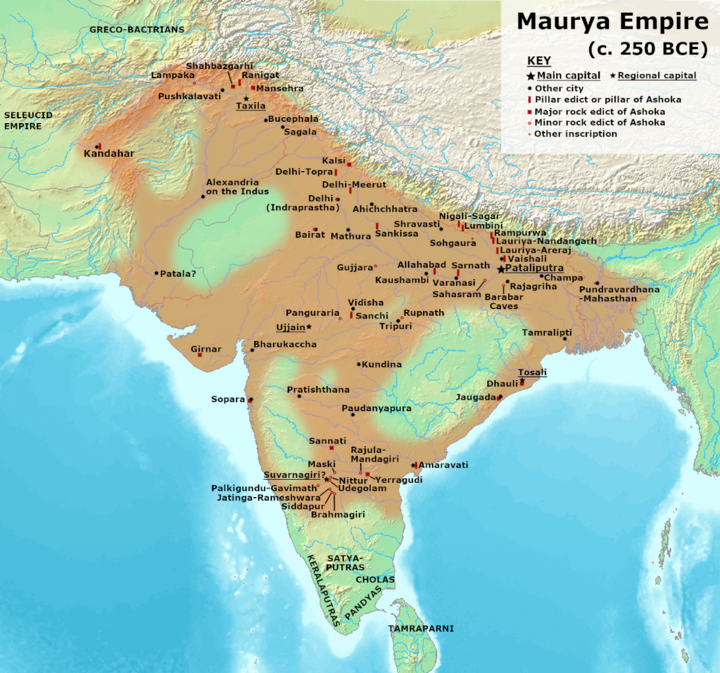
c. Satavahanas – After the death of Ashoka, the Mauryan empire soon disintegrated. Around 230 BCE, the Satavahanas broke free from Mauryan control and ruled the region for 400 years.
- Gautamiputra Satakarni (a notable ruler of the Satavahana Dynasty) defeated Scythian invaders.
- Note: Much of the present Karnataka and Andhra was also extended by them (undivided region).
- Many inscriptions of Satavahanas and also Buddhist caves excavated during their times confirms their territorial expanse.
- Old Satavahana coins have been found both in Maharashtra and Andhra.
- Gautamiputra Satakarni was the most famous and the best King of this dynasty.
- Their early capital was in Pratishthanapura (i.e., today’s Paithan in Maharashtra), the regime lasted till about 200 AD.
- The Satvahana dynasty mainly used the Prakrit language.
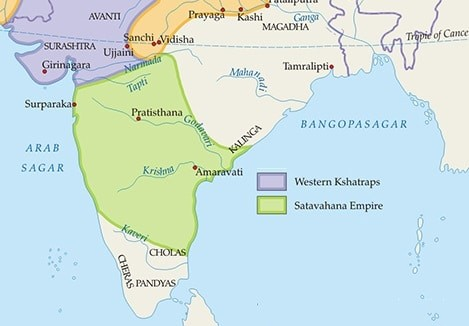
d. Vakatakas– Satavahana empire was followed by the Vakatakas. The dynasty ruled from approximately 250 to 470 CE.
- During their regime, much of Ajanta caves were excavated.
- They had cordial relations with the Gupta empire in the northern part of India. A Gupta princess named Prabhavatigupta married a Vakataka King.
- Their empire lasted till about 600 AD.
- Mansar (nearly 50 km from Nagpur) was their capital.
- The Vakataka dynasty used both Prakrit and Sanskrit languages.
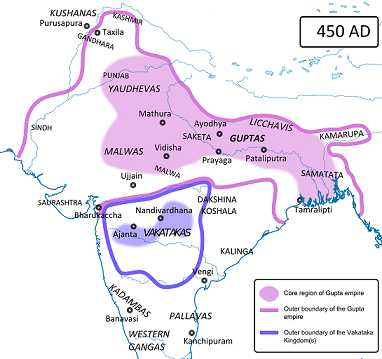
e.Chalukyas – Chalukyas ruled Maharashtra from the 6th century C.E. to the 8th century. This dynasty ruled both Karnataka and Maharashtra.
- The capital was in Badami (in the present Karnataka region).
- Two prominent rulers were Pulkeshin II (who defeated the north Indian Emperor Harsha) and Vikramaditya II (who defeated Arab invaders in the 8th century).
- They built some of the earliest temples in Maharashtra- the famous Kolhapur Mahalaxmi temple known as Karnadeva in about 624 AD.
- Pulikeshin II was the prominent ruler of this dynasty. In 618 AD, he defeated the mighty Harshavardhana in a battle fought around the banks of Narmada and secured the southern realm for himself.
- This empire endured till about 753 AD when Dantidurga, the new Rashtrakuta dynasty, overthrew the last Chalukya King.
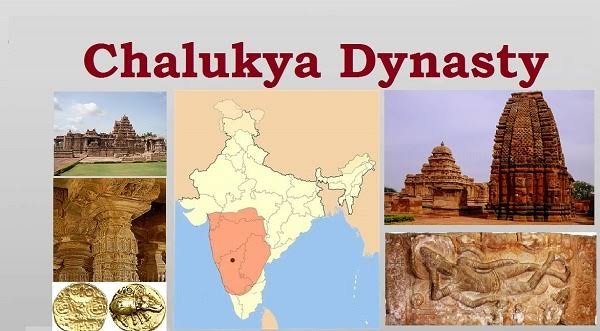
d. Rashtrakutas– This dynasty ruled Maharashtra from the 8th to the 10th century. The Arab traveller Sulaiman called the ruler of the Rashtrakuta Dynasty (Amoghvarsha) one of the four great kings of the world and regraded the dynasty as the powerful one in India at that time.
- It was under King Dantidurga that the famous Ellora caves and the Kailas temple were built.
- This dynasty was kind of like the Marathas- they made extensive conquests both in the north and the south and were renowned for their martial prowess.
- They fought a lot with the Northern and Eastern empires like the Gurjar-Pratiharas and the Palas to control the imperial city of Kannauj.
- This tri-partite war weakened all the parties and kind of paved the way for Muslim invasions.
- Their early capital was Latur (Maharashtra) and later Malkhed (Karnataka).
- Note: The Chalukya dynasty and Rashtrakuta Dynasty had their capitals in modern-day Karnataka and used Kannada and Sanskrit as court languages.
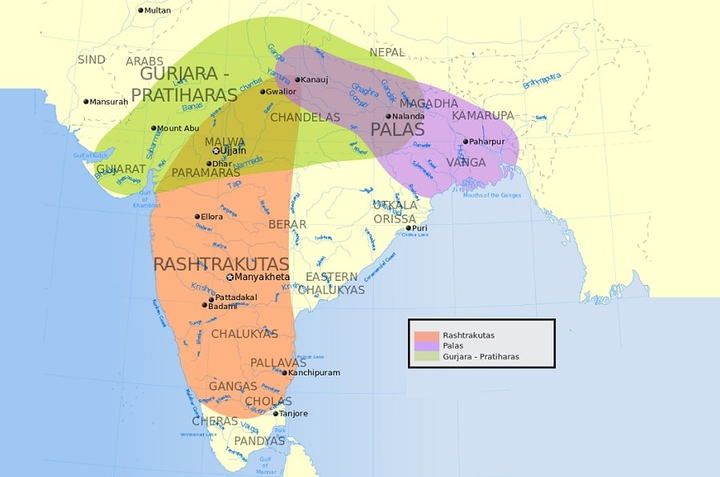
From the early 11th century to the 12th century, the Deccan Plateau, including a large part of Maharashtra, was dominated by the Chalukya and Chola dynasty. The records found several battles over the Deccan Plateau were fought between these Chalukyas and Chola empires. The war was fought during Raja Raja Chola I, Rajendra Chola I, Jayasimha II, Someshvara I, and Vikramaditya VI.
e. Shilaharas – After the fall of Rashtrakutas, many new local dynasties cropped up, the most prominent of which were Shilaharas, controlling almost the whole coastal strip of Maharashtra and some possessions in the lands east to the Sahyadris.
- Between 800 and 1200 CE, parts of Western Maharashtra, including the Konkan region of Maharashtra, were ruled by different Shilahara houses based in North Konkan, South Konkan, and Kolhapur.
- They built some stunning temples, e.g. the Khidrapur temple and forts, e.g. Panhala.
- They also engaged in naval conflicts. Kolhapur and Thane were the capitals of their independent branches.
- They were finished off by the Yadavas in about 1216.
Note: At different periods in their history, the Shilaharas served as the Vassals of the Rashtrakutas of the Chalukyas.
f. Yadava Dynasty –Yadavas were also regarded as powerful rulers and ruled parts of Karnataka and Andhra (undivided).
- Note: How Rashtrakutas fought with Gurjara Pratiharas and Palas, the Yadavas fought with the Hoyasalas, the Kakatiyas and the Gajapatis.
- The Yadavas dynasty was at its peak ruled its kingdom from Tungabhadra to Narmada rivers (the present Maharashtra, north Karnataka and parts of Madhya Pradesh).
- The capital of the Yadava dynasty was Devnagari (present-day Daulatabad in modern Maharashtra).
- The Yadavas initially ruled as feudatories of the Western Chalukyas.
- Their rule reached its peak under Singhania II. The Yadavas of Devagiri used Marathi as their court language.
- The Yadava capital Devagiri became a magnet for learned scholars in Marathi to showcase and find patronage for their skills.
- The origin and growth of Marathi literature are directly associated with the rise of the Yadava dynasty.
- Yadava dynasty is believed to be the first true Maratha empire.
- During their rule, a particular style of architecture called Hemadpanti (after Hemadri or Hemadpant, a minister of Mahadeva and Ramchandra) came into vogue.
The long wars destabilized the south; when the Khiljis invaded Maharashtra and defeated the Yadavas, they found the whole south under their control. Ala-ud-din Khilji invaded the kingdom of Ramchandra and suddenly appeared before the gates of Devagiri in 1294 AD. Ramchandra was taken unawares and could not hold out long and had to pay a heavy ransom to the Muslim conqueror.
However, he continued to rule till A.D. 1310 and his regime was succeeded by his son Shankaragana. On discontinuing the stipulated tribute to Delhi, he was then defeated and slained by Malik Kafur. This is how the Yadava dynasty to an end in A.D. 1318.
To download the PDF, click here:
Ancient History of Maharashtra, Download PDF
Important Subject Links
More From Us:
Maharashtra Static GK
MPSC Current Affairs 2022: Download in Marathi & English
Important Government Schemes For MPSC
NCERT Books for MPSC State Exam 2022
Maharashtra State Board Books PDF
MPSC GK Study Material: Complete Notes for MPSC Exam [Free]
Download BYJU’S Exam Prep App
 Daily, Monthly, Yearly Current Affairs Digest, Daily Editorial Analysis, Free PDF’s & more, Join our Telegram Group Join Now
Daily, Monthly, Yearly Current Affairs Digest, Daily Editorial Analysis, Free PDF’s & more, Join our Telegram Group Join Now



